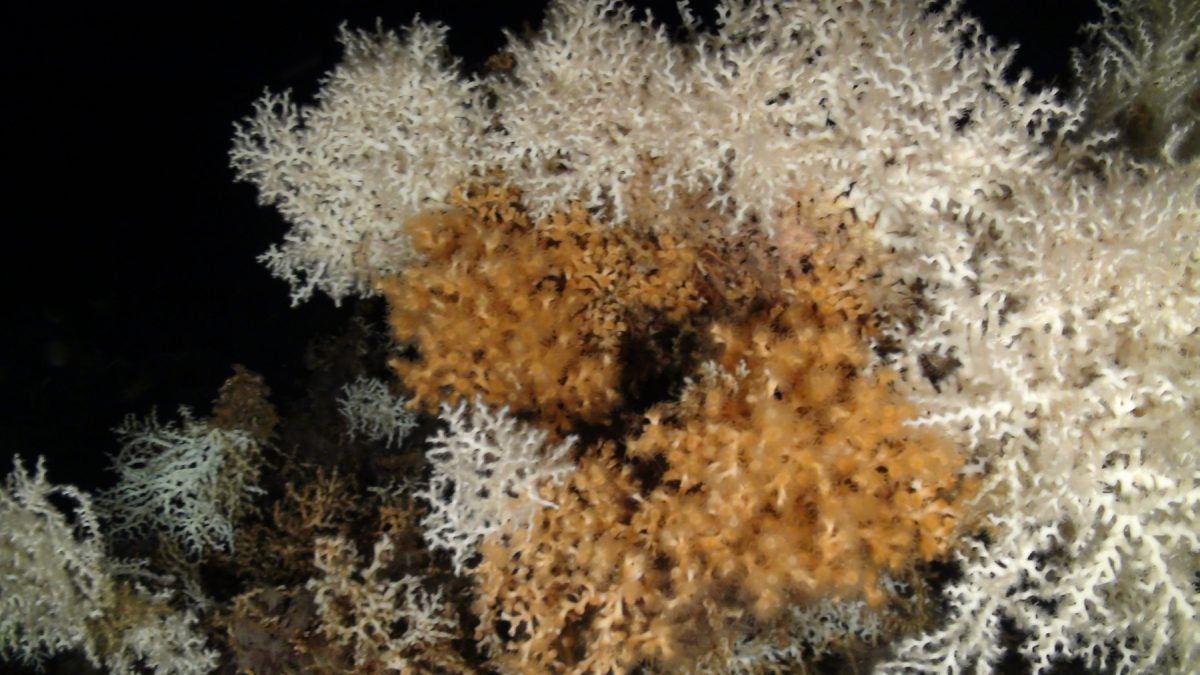July 1, 2022
Cabliers Bank – a deep-sea jewel one step closer to protection
BY: Helena Alvarez
Topics: Habitat Protection, Sustainable Fisheries
Until recently, the Cabliers Bank was a hidden jewel in the Mediterranean Sea. This underwater biodiversity treasure has survived throughout centuries, in the Alboran Sea, the westernmost part of the Mediterranean. Here, Mediterranean and Atlantic waters interact, and are very rich in nutrients. This part of the Mediterranean Sea is also one of the busiest marine areas in terms of fishing and marine traffic, with 25% of global maritime traffic crossing the Alboran Sea annually.[1]
Cabliers Bank is a coral mound formed by the deep-sea cold water coral species Desmophyllum pertusum and Madrepora oculata, and serves as an oasis where marine biodiversity thrives. It is inhabited by vulnerable and commercial species, and by others that are uncommon or for which their occurrence on the Cabliers Bank represent the first records in the Mediterranean, such as the black coral Phanopathes rigida, which is originally from the western Atlantic.
The Cabliers Bank lies in a transboundary area, in the waters of two neighboring countries: Morocco and Spain. Therefore, managing this area requires regional cooperation, and granting protection against the negative impacts of fishing must be done through the General Fisheries Commission of the Mediterranean (GFCM), the UN regulatory body entitled to designate fisheries closures, called Fisheries Restricted Areas (FRAs).
Oceana was the first to investigate the Cabliers Bank area in 2010,[2] followed by the Marine Science Institute – Spanish National Research Council (ICM-CSIC), which expanded the research and lately confirmed the uniqueness of this reef in the frame of the H2020 MSC Project HABISS “Eco-hydrodynamics of cold water coral habitats across integrated spatial scales”.[3] In constant dialogue with the parties concerned – Morocco, the European Union and the GFCM– Oceana and the ICM-CSIC have now officially proposed Cabliers Bank as a FRA under the GFCM. The reasons for safeguarding this semi-pristine, deep-sea coral reef are many, including its potential role as a refuge for young fish, and the fact that it seems to be the only cold-water reef in the Mediterranean Sea that is still growing.
 |
 |
 |
Images of Callogorgia verticillata with white brittle stars and Asconema setubalense (left) Lophelia pertusa and Madrepora oculata (centre), and Anthomastus cf. grandiflorus (right) captured by a remotely operated vehicle in Cabliers bank during the 2011 Expedition in the Alboran sea.
The process is a long-distance race, during which various experts, working groups and advisory bodies must evaluate and endorse the scientific data behind the proposal in order to proceed towards management and protection of the area. On 21-24 June 2022, an important milestone was achieved: the GFCM Scientific Advisory Committee (SAC) endorsed the Cabliers FRA proposal, agreeing on its technical soundness. The proposal will next be considered, and potentially be adopted, at the annual GFCM meeting in November 2022. Parties involved have also discussed the preliminary steps of a multi-year plan that includes the closure of the area to destructive fishing, together with further scientific research via an international research expedition to better define the final boundaries of this area and its management. This research expedition is expected to happen imminently. Oceana welcomes these significant advances by the GFCM, and thanks in particular the efforts of Morocco and the European Union for bringing the protection of Cabliers Bank and its unique reefs one step closer to reality.
[1] UNEP-MAP-RAC/SPA. (2015). Alboran Sea: Ecology and human activities (Draft Report). RAC/SPA: http://rac-spa.org/nfp12/documents/information/wg.408_inf18_eng.pdf
[2] Oceana. (2010, July 19). Oceana discovers one of the most important and threatened deep-sea coral reefs of the Mediterranean in the Alboran Sea [Press release] https://europe.oceana.org/en/press-center/press-releases/oceana-discovers-one-most-important-and-threatened-deep-sea-coral-reefs
[3] National Oceanography Centre (2021, January 21). Scientists discover how the potentially oldest coral reefs in the Mediterranean developed [Press release] https://noc.ac.uk/news/scientists-discover-how-potentially-oldest-coral-reefs-mediterranean-developed
Watch the video!


